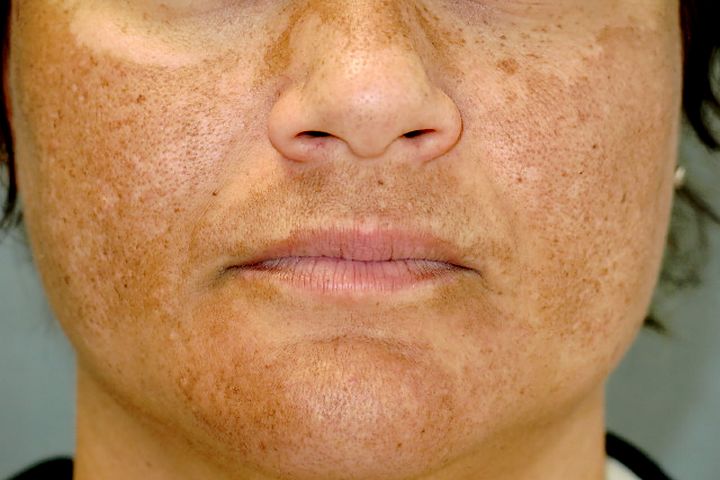
Having melasma on your face is by far the most common location. In most cases, forming a very similar pattern on each side of the face.
Melasma (or chloasma) and hyperpigmentation have much in common, they produce darker areas on your skin due to excess melanin. Whilst the difference between fair and brown skin is primarily higher melanin levels, this offers no protection, quite the opposite.
People with olive, or to a degree dark skin, are prone to melasma. Whilst anyone can be affected, women are more likely to be. Although influenced by the sun, melasma is a form of pigmenation caused by internal changes, such as hormone levels.
Hyperpigmentation can have a range of causes, including medication, skin damage, the wrong skin treatments but is mainly a result of sun exposure.
We bring both conditions together because seeing both in the same patient is not unknown and there is a degree of cross treatment. The key is accurately diagnosing your individual condition and understanding the best way forward for your skin colour.
A Personal Consultation
Melasma may become more noticeable in the summer than winter, yet not always. Pregnancy, or hormonal medication can be a cause, including the contraceptive pill, thyroid disorders could contribute, even the wrong cosmetics.
When you visit one of our consultant dermatologists, they will not only examine the affected areas. Talking with you matters, to understand your medical history, individual symptoms, your life and how this is affected.
Melasma, or most forms of hyperpigmentation, are rarely medical dangers, or painful. They do however have a significant impact on your life, are upsetting and warrant careful treatment.
The majority of pigmentation issues can be diagnosed by an experienced eye, perhaps a hand held microscope known as a dermascope, with imaging capabilities.
Sophisticated digital imaging and a full range of tests are still available, where they will help to formulate the right treatment plan. This includes state of the art diagnostic equipment, able to look beneath your skin, without requiring a surgical biopsy.
Melasma & Hyperpigmentation Treatment
Avoiding too much sunshine, using suitable sunscreen regulary, or a hat offering good shade can in a sense be part of treatment. Or assist in avoiding higher degrees of treatment to deal with your condition.
Topical treatments, such as hydroquinone, azelaic acid, or corticosteriod creams can be effective. A few types of oral medication may be helpful.
The most important aspect is to ensure selected treatments are suitable for darker skin and for your specific skin tone. Chemical skin peels are an example, they can be useful but the wrong choice could make matters worse.
Similar thoughts apply to the use of laser treatment. The belief that lasers can not be used on darker skin is something of a myth but the right type of up to date, fractional laser should be used, or damage can result.
CO2 fractional lasers can also be used in conjunction with medication applied to the skin. A 2020 trial alongside tranexamic acid treatment found they were as effective as micro needling, with less disturbance to the skin.
There are other options, we tend not to suggest them before a careful diagnosis. Neither is melasma always permanently curable, yet is almost always able to be controlled, with specialist skills applied.
Care At Our London Clinic
Skin Care Network’s London clinic offers dedicated melasma treatment, alongside care for a range of hyperpigmentation issues.
Melasma, as with other unwanted pigmentation, can affect the dermis, epidermis, or both layers of the skin. Early diagnosis naturally helps, although whatever the stage reached, our consultants will tailor treatment to suit.
Your skin colour, your feelings and wishes are part of decisions, our staff always treat the person, not the condition in an abstract way.
By all means read more on dermatology for darker skin. Or if we can help, you are welcome to arrange a visit to our clinic at any time.
For any assistance, or to book a consultation, call 020 8441 1043, or send an email via the Make An Appointment button below.
